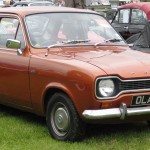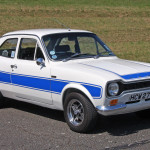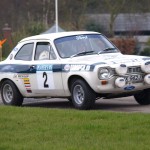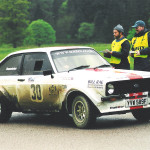Ford History
Ford Escort Mark I (Mk1) (1968–1974)
 The Mark I Ford Escort was introduced in the United Kingdom at the end of 1967, making its show debut at Brussels Motor Show in January 1968.[1] It replaced the successful long running Anglia. The car was presented in continental Europe as a product of Ford’sEuropean operation. Escort production commenced at Halewood in England during the closing months of 1967, and for left hand drive markets during the autumn/fall of 1968 at the Ford plant in Genk[2]. Initially the continental Escorts differed slightly from the UK built ones under the skin. The front suspension and steering gear were differently configured and the brakes were fitted with divided hydraulic circuits; also the wheels fitted on the Genk-built Escorts had wider rims.[1] At the beginning of 1970, continental European production transferred to a new plant on the edge of Saarlouis, West Germany. The MkI was also built in Israel between 1969 – 1975.
The Mark I Ford Escort was introduced in the United Kingdom at the end of 1967, making its show debut at Brussels Motor Show in January 1968.[1] It replaced the successful long running Anglia. The car was presented in continental Europe as a product of Ford’sEuropean operation. Escort production commenced at Halewood in England during the closing months of 1967, and for left hand drive markets during the autumn/fall of 1968 at the Ford plant in Genk[2]. Initially the continental Escorts differed slightly from the UK built ones under the skin. The front suspension and steering gear were differently configured and the brakes were fitted with divided hydraulic circuits; also the wheels fitted on the Genk-built Escorts had wider rims.[1] At the beginning of 1970, continental European production transferred to a new plant on the edge of Saarlouis, West Germany. The MkI was also built in Israel between 1969 – 1975.
The Escort was a commercial success in many parts of western Europe, but nowhere more than in the UK, where the national best seller of the 1960s, BMC’s Austin/Morris 1100 was beginning to show its age while Ford’s own Cortina had grown, both in dimension and in price, beyond the market niche at which it had originally been pitched. In June 1974, less than six years after the car’s UK introduction, Ford announced the completion of the two millionth Ford Escort, a milestone hitherto unmatched by any Ford model outside the USA.[3] It was also stated that 60% of the two million Escorts had been built in Britain.[3]
The Escort had conventional rear wheel drive and a four-speed manual gearbox, or 3 speed automatic transmission. The suspension consisted of a simple live axle mounted on leaf springs, but with rack-and-pinion steering. The Mark I featured contemporary styling cues in tune with its time: a subtle Detroit-inspired „Coke bottle” waistline and the „dogbone” shaped front grille — arguably the car’s most famous stylistic feature. Similar styling featured in the larger Cortina Mark III (also built in West Germany as the Taunus) that was launched in 1970.
Initially, the Escort was sold as a 2-door saloon (with circular front headlights and rubber flooring) on the „De Luxe” model. The „Super” model featured rectangular headlamps, carpets, a cigar lighter and a water temperature gauge. A 3-door estate was introduced at the end of March 1968 which, with the back seat folded down, provided an impressive 40% increase in maximum load space over the oldAnglia 105E estate, according to the manufacturer.[4] The estate featured the same engine options as the saloon, but it also included a larger 7½ inch diameter clutch, stiffer rear springs and in most configurations slightly larger brake drums or discs than the saloon.[4] Apanel van appeared in April 1968 and the 4-door saloon in 1969.
Underneath the bonnet was the Kent Crossflow engine which did find its way into the North American cousin Ford Pinto. Diesel engineson small family cars were very rare, so the Escort featured initially only petrol engines — in 1.1 L, and 1.3 L versions. A 940 cc engine was also available in some export markets, but few were ever sold.
There was a 1300GT performance version, with a tuned 1.3 L Kent (OHV) engine sporting a Weber carburetor and uprated suspension. This version also featured additional instrumentation with a tachometer, battery charge indicator and oil pressure gauge. The same tuned 1.3 L engine was also used in a variation sold as the Escort Sport, that used the flared front wings from the AVO range of cars, but featured trim from the more basic models. Later on a further „executive” version of the Escort was produced known as the 1300E. This featured the same 13″ road wheels and flared wings of the Sport, but was trimmed in an upmarket, for that time, fashion with wood trim on the dashboard and door cappings.
There was, in the early days of the Escort, a higher performance for rallies and racing — the Escort Twin Cam, which featured an engine with a Lotus-made 8-valve twin camshaft head fitted to the 1.5 L non-crossflow block, which had a bigger bore than usual to give a capacity of 1558 cc. Production of the Twin Cam, which was originally produced at Halewood, was phased out as the RS1600 was developed.
The Mark I Escorts became very successful as a rally car, and they eventually went on to become one of the most successful rally cars of all time.[5] The Ford works team was practically unbeatable in the late 1960s / early 1970s, and arguably the Escort’s greatest victory was in the 1970 London to Mexico World Cup Rally being driven by Finnish legend Hannu Mikkola. This gave rise to the famous Escort Mexico (1.6 L „Kent” engined) special edition road versions in honour of the rally car.
In addition to the Mexico, the RS1600 was developed which used a Kent engine block with a 16-valve Cosworth cylinder head. This engine was essentially a detuned Formula 3 engine designated BDA, for Belt Drive A Series. Both the Mexico and RS1600 were built at Ford’s Advanced Vehicle Operations (AVO) facility located at the Aveley Plant in South Essex. As well as higher performance engines and sports suspension, these models featured strengthened bodyshells, making them an ideal model for rallying. Even today Mark I Escorts are still popular in the amateur rally scene. The BDA engine has a distinctive growling which can be heard for quite a distance when the vehicle is being driven hard, such as in competition.
 Ford also produced an RS2000 model as a more „civilised” alternative to the somewhat temperamental RS1600, featuring a 2.0 L Pinto (OHC) engine. This also clocked up some rally and racing victories; and pre-empted the hot hatch market as a desirable but affordable performance road car. Like the Mexico and RS1600, this car was produced at the Aveley plant.
Ford also produced an RS2000 model as a more „civilised” alternative to the somewhat temperamental RS1600, featuring a 2.0 L Pinto (OHC) engine. This also clocked up some rally and racing victories; and pre-empted the hot hatch market as a desirable but affordable performance road car. Like the Mexico and RS1600, this car was produced at the Aveley plant.
The Escort quickly became one of Britain’s most popular cars, comfortably outselling the conceptually similar Vauxhall Viva HB launched two years earlier. It was also a success on export markets, though in the larger European markets it tended to be outsold by the Opel Kadett, its General Motors rival. The car was built in Germany, Britain and in Commonwealth countries such as Australia and New Zealand.
Ford Escort Mark II (Mk2) (1975–1980)
The squarer-styled Mark II version appeared in January 1975. The first production models had rolled off the production lines on 2 December 1974.
Unlike the first Escort (which was solely a British effort), the second generation was developed along with Ford of Germany. Codenamed „Brenda” during its development, it used the same mechanicals as the Mark I. The 950 cc engine was still offered in Italy but in larger markets elsewhere in Europe it was unavailable. The estate and van versions used the same panelwork as the Mark I, but with the Mark II front end and interior. The car used a revised underbody, which had in fact been introduced as a running change during the last six months of the life of the Mark I.
This car made a point, with just four body styles, of competing in many different market niches where rival manufacturers had either multiple model ranges or simply none at all. „L” and „GL” models (2-door, 4-door, estate) were in the mainstream private sector, the „Sport”, „RSMexico”, and „RS2000” in the performance market, the „Ghia” (2-door, 4-door) for an untapped small car luxury market, and „base / Popular” models for the bottom end. Panel-van versions catered to the commercial sector.
During the second half of the 1970s, the Escort continued to prove hugely popular with buyers in Britain and other parts of Europe.
A cosmetic update was given in 1978, with L models gaining the square headlights (previously exclusive to the GL and Ghia variants) and there was an upgrade in interior and exterior specification for some models. Underneath a wider front track was given.
In 1979 and 1980 three special edition Escorts were launched the Linnet, Harrier and Goldcrest.
Production, after an incredibly popular model run, ended in Britain in August 1980, other countries following soon after.
Rallying
 As with its predecessor, the Mark II had a successful rallying career. All models of the Mark I were carried over to the Mark II, though the Mexico gained the RS badge and had its engine changed to a 1.6 L OHC Pinto instead of the OHV, it had a short production span as customers either bought the much cheaper „sport” or the much more exotic „RS 2000” (a shame, as the RSMexico was basically an RS2000 without the ‘droopsnoot’). A „Sport” model was also produced using the 1.6 L Kent. Also a new and potent model was released, the RS1800, which had an 1800 cc version of the BDA engine. It was essentially a special created for rallying, and surviving road versions are very rare and collectible today. There has been a long standing debate regarding how the RS1800 was homologated for international motorsport, as Ford are rumoured to have built only fifty or so road cars out of the four hundred required for homologation.
As with its predecessor, the Mark II had a successful rallying career. All models of the Mark I were carried over to the Mark II, though the Mexico gained the RS badge and had its engine changed to a 1.6 L OHC Pinto instead of the OHV, it had a short production span as customers either bought the much cheaper „sport” or the much more exotic „RS 2000” (a shame, as the RSMexico was basically an RS2000 without the ‘droopsnoot’). A „Sport” model was also produced using the 1.6 L Kent. Also a new and potent model was released, the RS1800, which had an 1800 cc version of the BDA engine. It was essentially a special created for rallying, and surviving road versions are very rare and collectible today. There has been a long standing debate regarding how the RS1800 was homologated for international motorsport, as Ford are rumoured to have built only fifty or so road cars out of the four hundred required for homologation.
The works rally cars were highly specialised machines. Bodyshells were heavily strengthened. They were characterised by the wide wheelarch extensions (pictured right), and often by the fitment of four large spotlights for night stages. The BDA engine was bored to 2.0 L and gave up to 270 bhp (201 kW; 274 PS) by 1979. It was complemented by a strengthened transmission, five-speed straight-cut ZF gearbox, five-linked suspension and a host of more minor modifications. In this form, the Escort was perhaps not the most sophisticated of the rear-drive saloon cars that dominated rallying in the late 1970s, but it was reliable and powerful, and good enough to win in the hands of some of the best drivers of its day.
 The late 1970s were a very successful period in rallying for Ford. The Mark II Escort continued its predecessor’s unbeaten run on the RAC Rally, winning every year from 1975–79 and winning a variety of other events around the world as well. In the 1979 season of theWorld Rally Championship, Björn Waldegård took the drivers’ title, Hannu Mikkola was runner-up and Ari Vatanen finished the year in fifth place, all driving Escort RS1800s.
The late 1970s were a very successful period in rallying for Ford. The Mark II Escort continued its predecessor’s unbeaten run on the RAC Rally, winning every year from 1975–79 and winning a variety of other events around the world as well. In the 1979 season of theWorld Rally Championship, Björn Waldegård took the drivers’ title, Hannu Mikkola was runner-up and Ari Vatanen finished the year in fifth place, all driving Escort RS1800s.
These drivers’ successes throughout the year gave Ford the manufacturers’ title, the only time the company had achieved this until the 2006 season, when Marcus Grönholm and Mikko Hirvonen won title for Ford in Ford Focus RS WRC 06. Vatanen won the drivers’ title in 1981, again at the wheel of an RS1800. This victory came despite the arrival on the WRC scene of the venerable four-wheel drive Audi Quattro. Ford placed in the top three in the manufacturers’ championship for the sixth year in a row.
The 1.6 L (1598 cc/97 CID) engine in the 1975 1.6 Ghia produced 84 hp (63 kW) with 125 N·m (92 ft·lbf) torque and weighed 955 kg (2105 lb). For rally use, this can be compared to the 1974Toyota Corolla which output 75 hp (56 kW) and weighed 948 kg (2090 lb).
The 2.0 L RS2000 version, with its distinctively slanted polyurethane nose, and featuring the Pinto engine from the Cortina, was announced in the UK in March 1975[10] and introduced in Germany in August 1975,[11] being reportedly produced in both countries.[10] It provided a claimed 110 bhp[11] and a top speed of 110 mph (177 km/h). For acceleration to 100 km/h (62.5 mph) a time of just 8.9 seconds[11] was claimed by the manufacturers. The 2.0 L engine was also easily retro-fitted into the Mark I, and this became a popular modification, along with the Ford Sierra‘s five-speed gearbox, for rallying and other sports, especially given the Pinto’s tunability.
source: Wikipedia